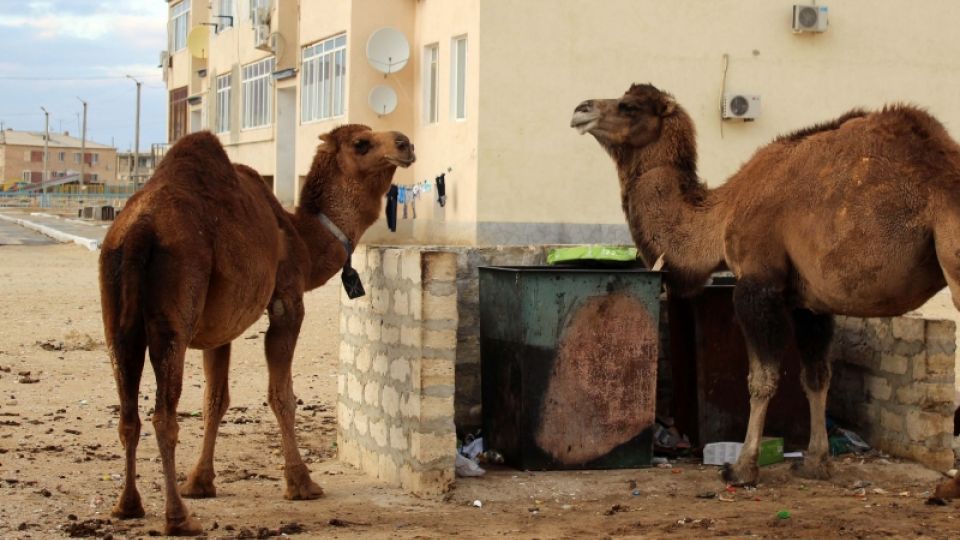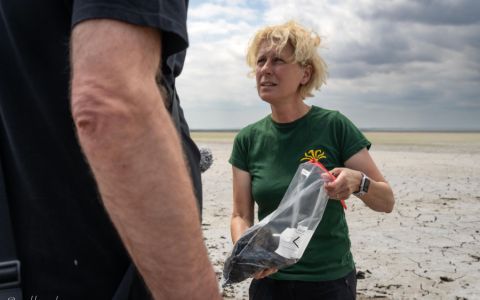Chicken eggs and camel milk are common components of the daily diet in Kazakhstan. They are also good indicators of possible pollution of the environment. That is why the Kazakhstani and Czech experts (1) analysed samples of free range chicken eggs (2) and fermented camel milk from several locations in Central Kazakhstan and the Mangystau Region during the last three years (3). New studies reveal alarmingly high concentrations of dangerous persistent organic pollutants (4). The contamination comes from industrial sources or waste from imported goods (5). The solution is not to stop eating eggs or drinking milk. Experts call the state authorities to complete an inventory of contaminated sites, fence them in, and start their remediation. The government of Kazakhstan can also contribute to global solutions by progressive positions at upcoming Meeting of the Parties to the Stockholm Convention (6).
“The camels are used to walking in the radius of several kilometres, so they are the ideal “natural sampling machines” for monitoring the wide surrounding area of a village or a farm. In the case of camel milk, the sources of contamination are old capacitors, industrial plants, abandoned production sites or mines, freely accessible waste dumps, and hazardous waste water reservoirs. Unfortunately, we saw many such places freely accessible with animals grazing at them,” says Dr. Jindrich Petrlik from non-governmental organization Arnika based in the Czech Republic and the main author of the research.
“Chickens monitor the state of their yard and its close vicinity. The eggs are probably contaminated from polluted soil and dust, undiscovered obsolete persistent organic pollutants (POPs) stockpiles or so far publicly unknown sources, including the waste on backyards such as car wrecks or polystyrene foams. Research should be carried out on potential sources of brominated flame retardants (7), obsolete PCB oils used in old capacitors and transformers and other potential sources of PCBs, such as paints or plaster. In certain regions, addressing the dioxin sources is also highly relevant. Respective sites contaminated by PCBs should be remediated throughout the country as soon as possible,” says Dr. Petrlik.
“Such contamination can cause serious malfunction of endocrine system, neurodevelopmental problems, or damage of the reproduction system, and they harm the health of children in particular. It is not of high concern if you sometimes eat contaminated egg. But, we must be aware that we constantly live in polluted environment, and dangerous chemicals enter our body not only through food, but also through air or water,” says Naila Dyusembaeva, a professor at Karaganda State Medial University.
“The state authorities should immediately take necessary measures. First of all, inventories of POPs contaminated sites and PCB stockpiles have to be finished. The easiest and cheapest measure is to fence and signpost dangerous places. Consequently, our government should start gradual remediation of these environmental hot spots,” says Anna Andreichuk, deputy director of Centre for Introduction of New Environmentally Safe Technologies. “The solution is not to discourage public from eating eggs and drinking milk, close the chicken farms down, or start punishing farmers, but to prevent further contamination of food chain,” adds Andreichuk.
These findings are highly actual as it is just a few days before world governments including the Kazakhstani one will gather at the 8th Conference of the Parties to Stockholm Convention on POPs in Geneva (4) where they will discuss limits for dangerous chemicals in wastes in order to limit their transboundary movement. That can help to prevent further contamination of the food chain globally. Waste is considered to be the major source of the pollutants found in egg samples.
The new studies were financed by the European Union and Transition Promotion Programme of the Czech Republic within the project “Enforcing citizens’ rights and public participation in decision-making on environmental issues – practical implementation of Aarhus Convention in Kazakhstan”.
Notes for editors:
1) More information on the project “Enforcing citizens’ rights and public participation in decision-making on environmental issues – practical implementation of Aarhus Convention in Kazakhstan”“Enforcing citizens’ rights and public participation in decision-making on environmental issues – practical implementation of Aarhus Convention in Kazakhstan”
2) Chicken eggs as the indicator of pollution of environment in Kazakhstan
4) Exposure to Persistent Organic Pollutants (POPs) can lead to serious health effects including certain cancers, birth defects, dysfunctional immune and reproductive systems, greater susceptibility to disease and damages of the central and peripheral nervous systems. POPs remain intact in the environment for long periods, become widely distributed geographically, accumulate in the fatty tissue of humans and wildlife. More information
Impacts of selected chemical substances on human health:
5) Examples of possible sources of contamination – animals grazing at contaminated sites in Mangystau Region
6) Stockholm Convention is an international environmental treaty, signed in 2001, that aims to eliminate or restrict the production and use of persistent organic pollutants (POPs). Upcoming meeting of the Convention will also decide about definition of certain limit values for POPs in wastes, e.g. about levels of hexabromocyclododecane (HBCD), which was found in high levels in chicken eggs in Kazakhstan. The eighth meeting of the Conference of the Parties to the Stockholm Convention will be held from 24 April to 5 May 2017 in Geneva (Switzerland) together with meeting of the Conference of the Parties to the Basel and Rotterdam Convention. More information: http://chm.pops.int/
7) Brominated flame retardants are a wide group of chemicals from which several are already on the list of those controlled or banned by the Stockholm Convention. More information: https://en.wikipedia.org/wiki/Brominated_flame_retardant
Detail information on pollution of camel milk and chicken eggs
CAMEL MILK
What have the experts found?
Samples of fermented camel milk were taken from farmers in six different locations in Mangystau and analysed for organic chemical substances and heavy metals. The results were compared with previous studies carried out by Kazakhstani experts. Levels of contamination in some samples, by polychlorinated biphenyls (PCBs) and zinc in particular, are alarmingly high. Polychlorinated biphenyls can cause cancer, harm liver or damage reproduction system. Zinc is responsible for anaemia and damage of pancreas.
“In certain parts of Mangystau, we can observe a disturbing increase in child morbidity rates. No doubt there is a link in long-term living near the industrially polluted spots,” says Kirill Osin, the director of non-governmental organization Eco Mangystau.
Toxic pollution in the surrounding areas of Caspian Sea might also be a reason for mass deaths of the seals in the sea in the year 2000. More than 15,000 seals died, most of them in the Northern Caspian Sea near Kazakhstan (more than 10,000). A large level of contamination resulting from the continuous long-term impact of the polluted environment on the animals was identified as a cause in combination with the virus of “canine distemper”. Highly concentrated PCB, DDT, chlordane, HCB and some heavy metals (such as zinc) found in the bodies of dead seals influenced their fertility and other physiological functions.
How to protect the health?
I am a farmer
- I make sure that my camels have access to pure food and water – for example, they graze in the steppe
- I avoid allowing my camels to graze at dangerous and polluted areas, such as uranium mines dumping sites, tailing ponds, industrial sites, etc.
- I avoid allowing my camels to eat from the waste containers, because I understand that it would be the same as if I eat the waste by myself
I am a consumer
- I will ask my farmer or supplier where they supply their dairy products from
- I do not buy milk produced in polluted areas or from farmers whose camels graze at polluted lands
- When I see camels grazing at polluted area or eat waste, I will document it and inform respective municipality and the Department of Consumers Protection
What can the local authorities do?
The municipalities should act! They have the ability to fence dangerous area, clean-up illegal waste dumping sites, organize proper waste management system, or demand from the government punishing violations of environmental legislation.
What can the government do?
The government should make an inventory of obsolete PCBs and sites contaminated with PCBs first, and then set up the plan for their remediation and the destruction of obsolete PCB oils. Securing funds from national and international sources can help. Safe clean-up and proper waste management is the only way to avoid serious health risks. It is also important to monitor and prevent contamination from polycyclic aromatic hydrocarbons which were found in camel milk in high, though not dangerous concentrations.
“Based on the experience with available technologies and the requirements of international Stockholm Convention we suggest the use of certain non-combustion technologies for the disposal of remaining PCB oils and wastes contaminated by PCBs,” Jindrich Petrlik explains the crucial steps.
CHICKEN EGGS
What have the experts found?
Samples of chicken eggs were collected at seven locations in Central Kazakhstan and at three locations in Mangystau Region. High levels of highly toxic dioxins and dioxin-like substances in eggs from Balkhash confirm serious contamination of the city. It is surprising that commercially distributed eggs bought in a supermarket in Karaganda contained high concentrations of brominated flame retardants as well. Shocking are high levels of PCBs, used in soviet times in transformer or hydraulic oils, in the eggs collected in a village in protected and theoretically clean area of Kyzyl Arai Mountains in Karagandy Region. High levels of dangerous chemicals found in eggs exceed both EU and Russian limits. Kazakhstani limits for dioxins in eggs are unfortunately absent.
The experts announced that they have found surprisingly high level of toxic hexabromocyclododecane (HBCD) in chicken eggs, which is of great concern. “We found, to our knowledge the highest ever measured concentration of HBCD in chicken eggs worldwide in the sample from Shetpe. These chemicals are not regularly monitored in Kazakhstan as they are not used in industrial production, but they are present in imported products such as cars or polystyrene insulation foams as flame retardants”, concludes Dr. Jindrich Petrlik, expert on toxic substances from Czech non-governmental organization Arnika and the main author of the new research. Eggs from Mangystau region also contained higher levels of already banned organochlorinated pesticides.
How to protect the health?
I have my own chickens
- I pay attention not to for example leave old car wrecks next to my house.
- I avoid using polystyrene for insulation of henhouses as chicken like to eat small polystyrene balls.
- I make sure chicken cannot enter sites potentially contaminated by oil spills from capacitors or transformers.
- I do not use used transformer oils at my house or yard – for example as an agent to fight termites.
- I do not buy chicken feed from farmers using organochloride pesticides or from areas next to cotton fields, where a lot of organochlorine pesticides used to be applied.
- If I live near potential pollution source such as metallurgical plant or cement kiln co-firing waste, I cover the chicken yard.
What can the government do?
- Set limits that stop importing wastes containing dangerous chemicals
- Finish inventory of POPs contaminated sites and PCB stockpiles
- Start remediation of contaminated sites







